Related Research Articles
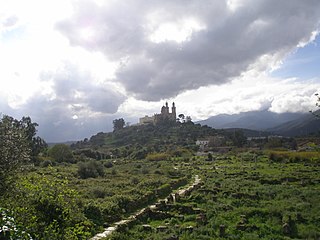
Hippo Regius is the ancient name of the modern city of Annaba, Algeria. It historically served as an important city for the Phoenicians, Berbers, Romans, and Vandals. Hippo was the capital city of the Vandal Kingdom from 435 to 439 AD. until it was shifted to Carthage following the Vandal capture of Carthage (439).
Parthenia was a Roman–Berber town in the former Roman province of Mauretania Sitifensis, the easternmost part of ancient Mauretania. It was located in what is now northern Algeria.
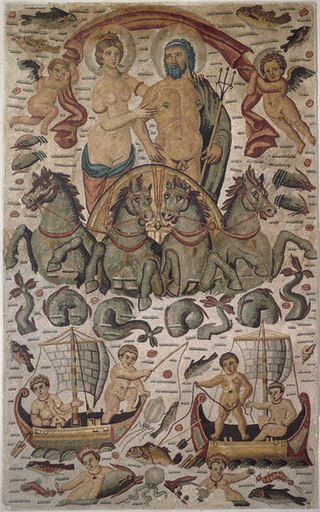
Cirta, also known by various other names in antiquity, was the ancient Berber, Punic and Roman settlement which later became Constantine, Algeria.

Mila is a city in the northeast of Algeria and the capital of Mila Province. In antiquity, it was known as Milevum or Miraeon, Μιραίον and was situated in the Roman province of Numidia.
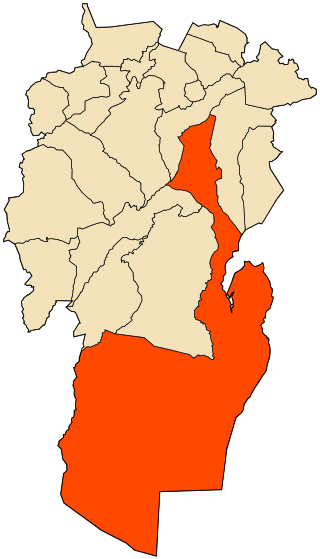
Babar is a municipality in Khenchela Province, northeastern Algeria. As Ancient Babra, a former bishopric, it remains a Latin Catholic titular see.

Mesarfelta was a Roman–Berber town in the province of Numidia. It was also a bishopric that is included in the Catholic Church's list of titular sees.

Caesarea in Mauretania was a Roman colony in Roman-Berber North Africa. It was the capital of Mauretania Caesariensis and is now called Cherchell, in modern Algeria. In the present time Caesarea is used as a titular see for Catholic and Eastern Orthodox bishops.

Tiddis was a Roman city that depended on Cirta and a bishopric as "Tiddi", which remains a Latin Catholic titular see.

Girus Tarasii was a town in the Roman province of Numidia that became a residential episcopal see. It is tentatively identified with ruins situated at what is now called Henchir-Tarsa in Algeria.
Azura was an ancient civitas and bishopric in Roman North Africa– It remains only as Latin Catholic titular see.
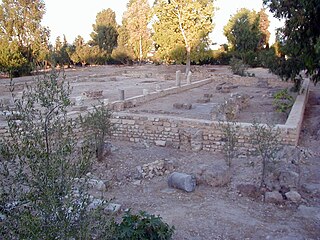
The Archdiocese of Carthage, also known as the Church of Carthage, was a Latin Catholic diocese established in Carthage, Roman Empire, in the 2nd century. Agrippin was the first named bishop, around 230 AD. The temporal importance of the city of Carthage in the Roman Empire had previously been restored by Julius Caesar and Augustus. When Christianity became firmly established around the Roman province of Africa Proconsulare, Carthage became its natural ecclesiastical seat. Carthage subsequently exercised informal primacy as an archdiocese, being the most important center of Christianity in the whole of Roman Africa, corresponding to most of today's Mediterranean coast and inland of Northern Africa. As such, it enjoyed honorary title of patriarch as well as primate of Africa: Pope Leo I confirmed the primacy of the bishop of Carthage in 446: "Indeed, after the Roman Bishop, the leading Bishop and metropolitan for all Africa is the Bishop of Carthage."
Musti in Numidia, also called Musti Numidiae, was an ancient city and bishop jurisdiction (bishopric), and is presently a Catholic titular see,(bishop's government see of a former government under a church's responsibility, also known as a dead diocese.) in modern Algeria.
Rotaria was an ancient Roman and Byzantine era bishopric of Numidia, North Africa.
Vagada, also known as Vagadensis and Bagatensis, was a town in the Roman-Berber province of Numidia. It was a Roman Catholic diocese.
Nigizubi was a Roman–Berber town in the province of Numidia. It was located in modern Algeria. It was also the seat of an ancient bishopric. during the Vandal Kingdom and Roman Empire. The exact location of the ancient town is now lost but it was somewhere in north-eastern Algeria.

Bagai was a Roman–Berber city in the province of Africa Proconsularis. It must have been of some reasonable size, as it was also the seat of an ancient Catholic bishopric. The ancient city has been identified with ruins at Ksar-Bagaï outside of Baghai, in the Aurès Mountains of the El Hamma District in Khenchela Province, Algeria.
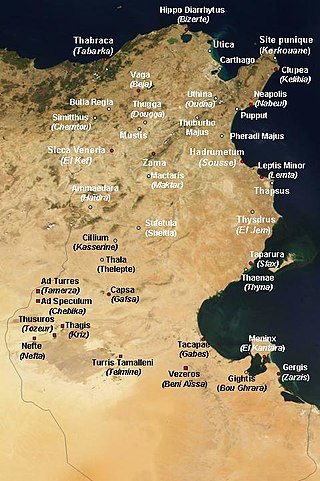
Medeli was an ancient Roman–Berber civitas of the Roman Province of Africa Proconsularis in Tunisia. It has been tentatively identified with Henchir-Mencoub and lasted through the Roman, Vandal and Byzantine empires.

Edistiana was an ancient Roman–Berber city in the province of Africa Proconsularis and in late antiquity of Byzacena. It was located in the modern Tunisia. It was a former Catholic diocese.
Baia was an ancient city and bishopric in the Roman province of Africa Proconsulare. It is a Roman Catholic titular see.
Vegesela (in Numidia) was an ancient city and former episcopal see in Roman North Africa and remains a Latin Church titular see of the Catholic Church.
References
- ↑ Vetera Romanorum itinera, sive Antonini Aug. itinerarium(1735).
- ↑ Joseph BINGHAM, Origines Ecclesiasticae, or the Antiquities of the Christian Church, and other Works (Straker, 1840) p229.
- ↑ Pius Bonifacius Gams, Series episcoporum Ecclesiae Catholicae, (Leipzig, 1931), p. 468.
- ↑ Stefano Antonio Morcelli, Africa christiana, Volume I, (Brescia 1816), pp. 295–296.
- ↑ H. Jaubert, "Anciens évêchés et ruines chrétiennes de la Numidie et de la Sitifienne, in Recueil des Notices et Mémoires de la Société archéologique de Constantine, vol. 46, 1913, p. 78.